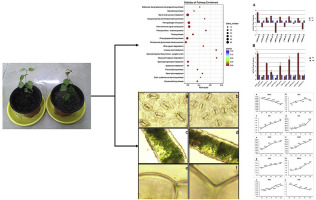当前位置:
X-MOL 学术
›
Phytochemistry
›
论文详情
Our official English website, www.x-mol.net, welcomes your feedback! (Note: you will need to create a separate account there.)
Transcriptome sequencing of the apricot (Prunus armeniaca L.) and identification of differentially expressed genes involved in drought stress
Phytochemistry ( IF 3.8 ) Pub Date : 2020-03-01 , DOI: 10.1016/j.phytochem.2019.112226 Jia Liu 1 , Jia Lin Deng 1 , Yun Tian 1
Phytochemistry ( IF 3.8 ) Pub Date : 2020-03-01 , DOI: 10.1016/j.phytochem.2019.112226 Jia Liu 1 , Jia Lin Deng 1 , Yun Tian 1
Affiliation

|
Apricot (Prunus armeniaca L.) is an important fruit crop that is widely planted throughout the world. But drought affects both yield and quality of apricot. In order to study the effects of long-term drought on the molecular and physiological mechanisms of apricot, we used transcriptome sequencing and measured physiological indices. First, 322 million high-quality clean reads were obtained, and 74,892 unigenes were generated for the transcriptome. Among the assembled unigenes, 18,671 simple sequence repeats (SSRs) and 5581 differentially expressed genes (DEGs) were identified. The Kyoto Encyclopedia of Genes and Genomes (KEGG) analysis of the DEGs revealed that starch and sucrose metabolism, plant-pathogen interaction and plant hormone signal transduction pathways are enriched. Additionally, we used quantitative real-time PCR (qRT-PCR) to confirm the RNA-seq results with 11 drought-related DEGs. Second, through the physiological analysis of apricot leaves under constant drought stress, and the results show the internal microstructure of apricot leaves changed to withstand drought stress. At the same time, plants exposed to long-term drought stress showed higher degree of membrane damage, which reduced photosynthesis in the damaged leaves. Our findings enrich the genome resources for apricot and refine our understanding of the molecular and physiological mechanisms of drought response in this fruit crop, providing insights into drought adaptation of the apricot.
中文翻译:

杏 (Prunus armeniaca L.) 的转录组测序和干旱胁迫相关差异表达基因的鉴定
杏(Prunus armeniaca L.)是一种重要的水果作物,在世界各地广泛种植。但干旱会影响杏的产量和品质。为了研究长期干旱对杏分子和生理机制的影响,我们使用转录组测序并测量了生理指标。首先,获得了 3.22 亿个高质量的干净读取,并为转录组生成了 74,892 个 unigene。在组装的 unigenes 中,鉴定了 18,671 个简单序列重复 (SSR) 和 5581 个差异表达基因 (DEG)。京都基因和基因组百科全书 (KEGG) 对 DEG 的分析表明,淀粉和蔗糖代谢、植物-病原体相互作用和植物激素信号转导途径得到了丰富。此外,我们使用定量实时 PCR (qRT-PCR) 来确认 11 个与干旱相关的 DEG 的 RNA-seq 结果。其次,通过持续干旱胁迫下杏叶的生理分析,结果表明杏叶内部微观结构发生变化以抵御干旱胁迫。同时,长期暴露于干旱胁迫的植物表现出更高程度的膜损伤,从而降低了受损叶片的光合作用。我们的发现丰富了杏的基因组资源,并完善了我们对这种水果作物干旱反应的分子和生理机制的理解,为杏的干旱适应提供了见解。结果表明,杏叶的内部微观结构发生了变化以抵御干旱胁迫。同时,长期暴露于干旱胁迫的植物表现出更高程度的膜损伤,从而降低了受损叶片的光合作用。我们的发现丰富了杏的基因组资源,并完善了我们对这种水果作物干旱反应的分子和生理机制的理解,为杏的干旱适应提供了见解。结果表明,杏叶的内部微观结构发生了变化以抵御干旱胁迫。同时,长期暴露于干旱胁迫的植物表现出更高程度的膜损伤,从而降低了受损叶片的光合作用。我们的发现丰富了杏的基因组资源,并完善了我们对这种水果作物干旱反应的分子和生理机制的理解,为杏的干旱适应提供了见解。
更新日期:2020-03-01
中文翻译:

杏 (Prunus armeniaca L.) 的转录组测序和干旱胁迫相关差异表达基因的鉴定
杏(Prunus armeniaca L.)是一种重要的水果作物,在世界各地广泛种植。但干旱会影响杏的产量和品质。为了研究长期干旱对杏分子和生理机制的影响,我们使用转录组测序并测量了生理指标。首先,获得了 3.22 亿个高质量的干净读取,并为转录组生成了 74,892 个 unigene。在组装的 unigenes 中,鉴定了 18,671 个简单序列重复 (SSR) 和 5581 个差异表达基因 (DEG)。京都基因和基因组百科全书 (KEGG) 对 DEG 的分析表明,淀粉和蔗糖代谢、植物-病原体相互作用和植物激素信号转导途径得到了丰富。此外,我们使用定量实时 PCR (qRT-PCR) 来确认 11 个与干旱相关的 DEG 的 RNA-seq 结果。其次,通过持续干旱胁迫下杏叶的生理分析,结果表明杏叶内部微观结构发生变化以抵御干旱胁迫。同时,长期暴露于干旱胁迫的植物表现出更高程度的膜损伤,从而降低了受损叶片的光合作用。我们的发现丰富了杏的基因组资源,并完善了我们对这种水果作物干旱反应的分子和生理机制的理解,为杏的干旱适应提供了见解。结果表明,杏叶的内部微观结构发生了变化以抵御干旱胁迫。同时,长期暴露于干旱胁迫的植物表现出更高程度的膜损伤,从而降低了受损叶片的光合作用。我们的发现丰富了杏的基因组资源,并完善了我们对这种水果作物干旱反应的分子和生理机制的理解,为杏的干旱适应提供了见解。结果表明,杏叶的内部微观结构发生了变化以抵御干旱胁迫。同时,长期暴露于干旱胁迫的植物表现出更高程度的膜损伤,从而降低了受损叶片的光合作用。我们的发现丰富了杏的基因组资源,并完善了我们对这种水果作物干旱反应的分子和生理机制的理解,为杏的干旱适应提供了见解。



























 京公网安备 11010802027423号
京公网安备 11010802027423号